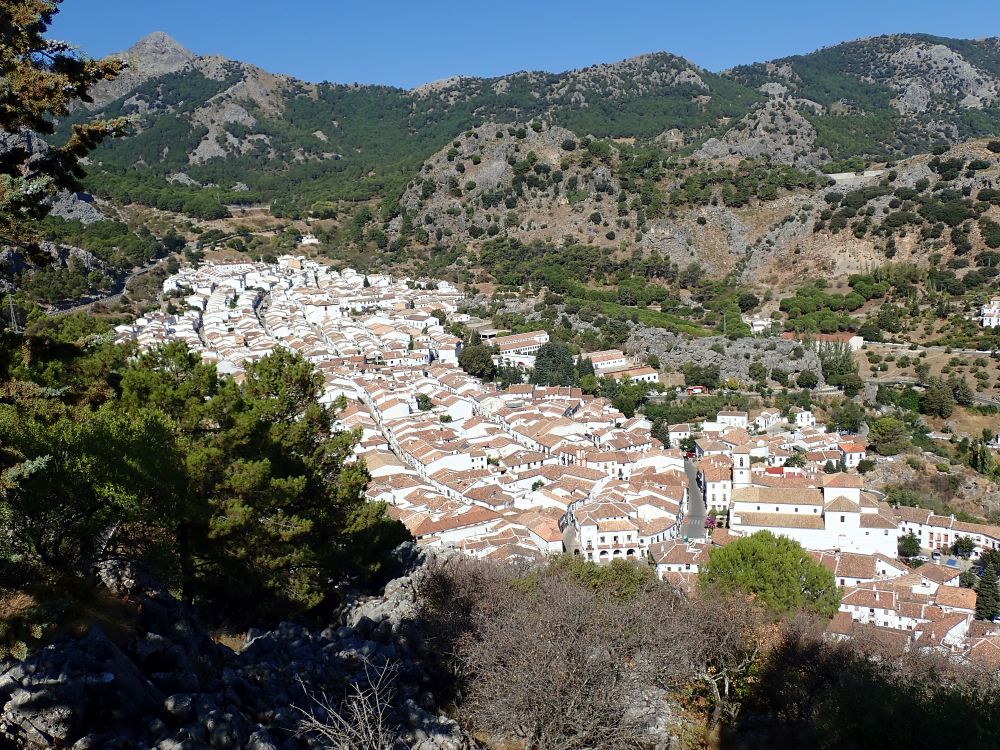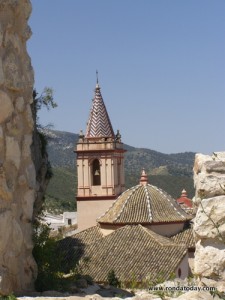Nestled under the mountain that gives the village its name, Zahara de la Sierra is one of the pueblos blancos of Cadiz province, and is only 30 minutes drive from Ronda, or an hour from Jerez de la Frontera. Completely within the Grazalema Natural Park, and with the district’s largest lake at its base, as well as the beginnings of the Garganta Verde walk just outside the village, Zahara is rightly quite central to experiencing the Sierra de Cadiz.

Listen to our podcast about Zahara de la Sierra
Zahara de la Sierra, a pueblo blanco in Cadiz, Spain, is the focus of this descriptive podcast.
Go straight to booking a hotel in Zahara de la Sierra
The Traditional Gastronomy of Zahara de la Sierra
The culinary heritage of Zahara de la Sierra is deeply rooted in the authentic flavors of its local, mountain-sourced ingredients. The village’s cuisine retains its traditional essence, offering a taste of history in every dish.
Zahara’s gastronomy features a wide variety of rustic and flavorful dishes, including asparagus omelets and stews, gachas (a type of porridge), quemones (a local stew), tagarninas (wild thistle stews), chard with chickpeas, olives, and iconic soups like sopa hervía or sopa tostá (both rustic bread-based soups), tomato soup, and menudo (a tripe stew). Local delicacies also include cured meats (chacinas) and unique desserts like quince-based sweets.
Some nice aerial shots of Zahara de la Sierra
A short history of Zahara de la Sierra
During the wars between what was left of Al-Andalus ruled by the Nasrids in Granada, Zahara was one of the frontier villages that protected Ronda and the city of Malaga from Christian raids, and even though the Nasrid’s were officially a client state of the Spanish nobility, there certainly wasn’t any love lost between them. The fortress was the Moorish watchtower of the area, but in those days a series of other defensive structures also existed, some of the foundations of which are still visible now. The current tower was built in the 1400s, replacing a previous Moorish tower.

Zahara de la Sierra, contrary to popular lore is not named after the orange blossom that seems to fill the air in the streets. Azahar (orange blossom) and orange trees are plentiful in the area, in fact many of the village streets are lined with short trees that in season are filled with oranges. Part of the confusion lies in one of the official names of the village after the Christian reconquest when it was known as Zahara de los Membrillos, which refers to the quince trees in the area, but the name Zahara has a different meaning in Arabic, referring to a big rock, which is precisely what the village sits on, a huge big rock.
Historically the location of the village has been used by many different people, starting with neolithic who probably used the caves that dot the area, and evidence of their presence is felt in the polished axe heads and pottery dug up in local farms over the years. By Roman times the thriving city of Acinipo was the centre of a large district, and evidence of Roman villas and a Roman bridge still exist.
Iberian people during the Visigoth era continued their Roman culture long after the fall of the Western Roman Empire, and archaeologists have found several burial crypts and part of a church altar dating from this period, but the first mention of Zahara as a definite location can be dated to 1282 when Sultan Yusef Aben of Morocco and the Castilian king Alfonso X met to discuss an alliance to defeat Sancho IV who had rebelled from his father’s rule. We are not certain how big the village was at the time, but it is unlikely to have been very big since it had been founded as a frontier fortress.
Zahara de la Sierra today.
Today, walking through Zahara one could be forgiven for imagining that nothing of these times exists, the village gives the apearance of being a thoroughly Andalusian and Christian mountain village, with only the ruins of the Moorish fortress left to tell the story of over two hundred years of almost constant unrest between the Christians of the north and Muslims of the south.
There are two churches in the village, both of them very close together, and between them a short strip of shops, hotels, restaurants, and the town hall. In the morning the village square and restaurants are filled with local people enjoying breakfast in the sun, but by lunch time the tourists have taken over, and then in the evening a pleasant mix of locals and visitors share these spaces together.
Your walk around the village is sure to be relaxing, Zahara de la Sierra isn’t large, and two to three hours is sufficient to see the pretty manicured streets with their citrus trees, to appreciate Zahara’s few monuments such as the church of Santa Maria, the clock tower, the chapel of San Juan de Letran, and a small marble statue representing Nuestre Señora de Zahara.
The highlight of your walk will undoubtedly be the ruins of the medieval village and the Castle tower (Torre del homenaje), at the base of which is a museum that offers a fascinating commentary on the history of Zahara and the fortress.
If you can, take the steps to the top of the tower and marvel at the views of the village, the lake, and the countryside. It truly is spectacular.
Where to stay in Zahara de la Sierra?
Hotel Restaurant Al Lago
After your walk around the village, enjoy a local tapas lunch in the village square, or if views of the lake are more your thing, the hotel and restaurant Al Lago has a wonderful outdoor terrace and contemporary Spanish menu and a selection of Ronda wines to enjoy.

Apart from Al Lago Zahara de la Sierra has a large selection of hotels, apartments and guest houses to choose from. Check out the offers over at booking.com.
White village tours

Sue from Nature Plus – Grazalema will be very happy to pick you up from your hotel in Ronda and take you on a journey of discovery with guided excursions and white villages of the Sierra de Grazalema.
FAQ – Zahara de la Sierra, Pueblo Blanco in the Grazalema Natural Park
Zahara de la Sierra is a stunning white village (“pueblo blanco”) in Cádiz province, set within the Grazalema Natural Park. It perches atop a rocky hill above the Zahara–El Gastor reservoir and lies just 30 minutes from Ronda.
Originally a Moorish fortress built in the 13th and 14th centuries, Zahara served as a defensive outpost between Nasrid Granada and Christian territories. The current castle tower dates from the 1400s.
Evidence of Neolithic, Roman, Visigoth, and Moorish presence has been found here—ranging from polished axes and burial crypts to Roman villas and medieval Islamic fortifications.
Highlights include the castle ruins and Torre del Homenaje (with panoramic views), the Church of Santa María de la Mesa, and the clock tower. Don’t miss the museum at the castle’s base.
Yes—Garganta Verde, a dramatic 400 m-deep gorge, lies just 5 km away. It’s a medium‑to‑high difficulty trail requiring a permit through local park offices.
The reservoir at the village’s foot invites kayaking, paddle‑surfing, swimming, and relaxing at the small beach (“playita”).
The Sierra de Grazalema Park is rich in biodiversity: Spanish fir (“pinsapo”) forests, griffon vultures, eagles, orchids, diverse mammals and amphibians.
Ideal visits are in spring and autumn. Access is easiest by car via A‑382 or CA‑531. Buses exist but are less frequent; main airports—Málaga, Seville, Jerez—are 1–2 hours away.
Zahara hosts Corpus Christi, San Juan, a mid‑May pilgrimage (Romería de Bocaleones), August Feria, September religious festivities, and an October historical “Toma de la Villa” re-enactment.
Its whitewashed streets, citrus‑lined lanes, historic churches, castle ruins, turquoise reservoir, and hilltop vantage points combine into an iconic, photograph-ready Andalusian landscape.
I’ve been living in this lovely area of Western Andalucia for the last 20 years or so and dedicate most of my time to the running of English language tourist information websites for the towns of Cádiz, Ronda, Grazalema, the famous or infamous Caminito del Rey, and also Wildside Holidays, which promotes sustainable and eco-friendly businesses running wildlife and walking holidays in Spain. My articles contain affiliate links that will help you reserve a hotel, bus, train or activity in the area. You don’t pay more, but by using them you do support this website. Thankyou!




2 thoughts on “Zahara de la Sierra Pueblo Blanco in the Grazalema Natural Park”